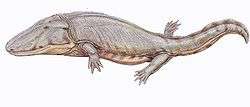Paracyclotosaurus
| Paracyclotosaurus Temporal range: Middle Triassic–Late Triassic | |
|---|---|
| | |
| Paracyclotosaurus davidi in the Natural History Museum of London | |
| Scientific classification | |
| Kingdom: | Animalia |
| Phylum: | Chordata |
| Class: | Amphibia |
| Order: | Temnospondyli |
| Superfamily: | Capitosauroidea |
| Family: | Capitosauridae |
| Genus: | Paracyclotosaurus Watson, 1958 |
| Species | |
| |

Paracyclotosaurus (Near Wheeled Lizard) is an extinct genus of temnospondyl amphibian, which would have appeared similar to today's salamander – but much larger, at up to 2.3 metres (7.5 ft) long. It lived in the Middle Triassic period, about 235 million years ago, and fossils have been found in Australia, India, and South Africa.
Although they could live on dry land, Paracyclotosaurus probably spent most of its time in water. They had flattened bodies and elongated heads, almost 60 centimetres (2 ft) long, that vaguely resembled those of modern crocodiles.[1]
A fish-eater, it might have lain in wait for prey, just below the surface of the water. When an unsuspecting fish came within reach of its jaws, Paracyclotosaurus lifted its massive head, its mouth opened wide and the fish was sucked inside. Modern predators, such as crocodiles, use this technique to catch some of their prey.
The species P. davidi is only known from one complete specimen recovered from Australia. It was discovered by quarry miners in a brick pit in St. Peters in Sydney, New South Wales. The creature was probably killed by a tree crushing the back of its head.
References
- Patricia Vickers-Rich and Thomas Hewett Rich 1993, Wildlife of Gondwana, ISBN 0-7301-0315-3 Reed.
